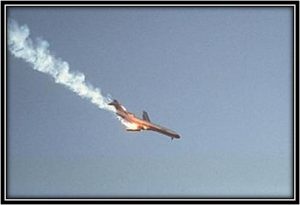PSA Flight 182
Contributor: Barry Fetzer
Sources: Wikipedia, History.com
When I was stationed overseas, about this same time thirty years ago, we were blessed to take a trip from Okinawa to China. While in China, we flew on regional Chinese airlines to several different locations in China. We were just a couple of the few foreigners aboard the aircraft. I remember looking at bald tires on the aircraft we were about to board that would have easily failed a maintenance inspection (and preflight check) in America, grounding the aircraft until the tires were replaced. But not in China, at least not at that time in the mid-1990’s. Perhaps it’s different now, thirty years later.
And as an aviator myself, it occurred to me, then, that my wife and I were placing our lives in the hands (literally in the hands) of the Chinese pilots manipulating the flight controls…flying what seemed to me to be a somewhat rickety aircraft.
We generally don’t think that way here in America. We board aircraft with hardly a thought to the fact that we, even here and even now in 2023, are placing our lives in the hands of the people who maintained and inspected the aircraft, the two folks up front in the cockpit, and the flight controllers behind the radar screens the ground.
But in America, at least, we’re fortunate to have some of the safest, most technically up-to-date, inspected-in-detail, and tightly regulated aircraft maintenance, training, and air traffic control procedures in the world.
But even with all those benefits, we’re human and mistakes happen. Whether we want to think about it or not as we board the next aircraft on which we’re flying, the reality is that the next tragic aviation accident is only one mistake away.
On this day in aviation history on September 25, 1978, there was a big mistake, or rather series of mistakes. According to History.com, “Forty-five years ago today a Pacific Southwest Airlines jet collided in mid-air with a small Cessna over San Diego, killing 153 people. The wreckage of the two planes fell into a populous neighborhood and did extensive damage on the ground.
David Lee Boswell and his instructor, Martin Kazy, were in the process of a flying lesson in a single-engine Cessna 172 on the morning of September 25, practicing approaches at San Diego’s Lindbergh Field airport. After two successful passes, Boswell aimed the Cessna toward the Montgomery Field airport northeast of San Diego.
At the same time, Pacific Southwest Flight 182 was approaching San Diego. The jet, a Boeing 727, was carrying 144 passengers and crew members from Sacramento, after a stopover in Los Angeles. Though air-traffic controllers at Lindbergh had told Boswell to keep the Cessna below 3,500 feet altitude as it flew northeast, the Cessna did not comply and changed course without informing the controllers.
The pilots of Flight 182 could see the Cessna clearly at 9 a.m., but soon lost sight of it and failed to inform the controllers. Meanwhile, the conflict-alert warning system began to flash at the air-traffic control center. However, because the alert system went off so frequently with false alarms, it was ignored. The controllers believed that the pilots of the 727 had the Cessna in view. Within a minute, the planes collided.

PSA Flight 182 seconds after the collision with the Cessna 172.
Courtesy Wikipedia.
The fuel in the 727 burst into a massive fireball upon impact. A witness on the ground reported that she saw her “apples and oranges bake on the trees.” The planes nose-dived straight into San Diego’s North Park neighborhood, destroying 22 homes and killing seven people on the ground. All 144 people on the 727 were killed, as well as both of the Cessna’s pilots.”







